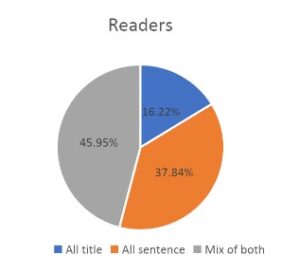Title case vs sentence case headings – which to choose?
October 17, 2022 • Timothy Roberts

Introduction
Language changes quickly … and internet language changes at lightning speed.
But is change always good, or are the old ways sometimes better?
This age-old adage crops up when considering two rival heading styles – sentence case and title case.
Before diving into this thorny issue, let’s get our definitions straight.
- Title Case is When Every Initial Letter of a Title, Headline, or Heading is Capitalised, Apart From Conjunctions, Connectives, and Other Small Words. (See what I did there?)
- Sentence case is when only the first letter of a heading is capitalised, apart from proper nouns such as ‘Yemen’ or ‘Obama’.
Even though title case has been the traditional heading choice for centuries, could its reign finally be drawing to a close?
Let’s find out.
Discussion
There’s obviously a clear visual difference between title and sentence case – but many have claimed there’s a comprehension benefit, too.
However, the science on this is surprisingly murky.
It used to be accepted wisdom that title case was faster and easier to read than sentence case. According to this theory, the heads and tails of all those letters above and below the line (‘ascenders and descenders’, to use linguistic lingo) aid comprehension. The ‘lumpier’ look of title case, the theory goes, helps our eyes differentiate each word.
Research doesn’t seem to support this idea, though. It’s now accepted that each word’s unique shape doesn’t actually significantly aid our reading speed or comprehension (though it apparently makes single-letter recognition slightly faster).1
There’s even a school of thought arguing that the more varied look of title case impedes reading, because it ‘disrupt[s] the eye’s flow, making it slower to read and comprehend.2 In other words, the opposite of conventional wisdom.
Given these disagreements over readability, it’s safe to assume that the jury’s still out.
So with the science still unsettled, let’s shift attention to the burning question: What do people prefer?
Method
To gauge people’s thoughts on this, we polled two separate groups – writers and readers – on which option they liked best. Our questionnaire asked:
Which option do you prefer?
- All headings in title case
- All headings in sentence case
- A mix of both.
We also included an optional ‘Comments’ section, so respondents had a chance to provide more detailed feedback.
Results
Writer results
We received 43 responses from writers, with their preferences broken down as follows:
Graph
Preference Percentage
All headings in title case 9.30% 
All headings in sentence case 74.42%
A mix of both 16.28%
As you can see, many writers love sentence case. ‘All sentence case’ is far and away the most popular choice, with almost three-quarters of respondents (74.42%) choosing sentence case as the #1 option for all heading types.
And even though almost twice as many writers (16.28%) preferred a mix of sentence and title case over title case only (9.30%), these combined results are dwarfed by the group’s extremely strong support for sentence case.
Now for the comments (which, remember, are more about judging ‘the vibe’ than about quantitative data).
It’s here that writers’ undying love of sentence case jumps clean off the page.
Sentence case is described as ‘simple[r]’, ‘clean’, and ‘calm’; more ‘professional’, ‘natural’, and ‘relaxed’; and ‘easier to read’. Two writers also praise sentence case as easier on editors, preventing confusion and disagreements when writing headlines.
While most writers love sentence case, they don’t feel the same about title case on the whole.
In the mildest criticism, some simply see title case as redundant. (Two sensibly suggest using bolding, colour, and size for emphasis instead.) Another baldly states: ‘I just don’t like it’.
Then there was the shoddiness angle.
While one writer calls title case ‘grammatically wrong’, more hate it for its intrusiveness or ‘sales pitch’ tone. Common descriptions include ‘pushy’, ‘tacky’, ‘for try-hards’, and ‘shouty’. One writer humorously compares title case to ‘get rich quick sites’, while another sees it as appropriate for the much-despised ‘10 Ways To Lose 10kg Without Giving Up Cake’ genre.
Ouch!
Now, let’s look at the most extreme comments from writers about title case.
Some loathe it.
Several describe title case in scathing terms, including ‘horrendous’, ‘unnatural’, and ‘awful’. One even claims that ‘excessive caps makes my brain hurt’.
But even in this inhospitable environment, a couple of (very) grudging positives emerged.
Two writers prefer title case for (very) short titles. Another writer mentions that ‘title case converts higher than sentence case’ (results in more sales) … but adds that they’re ‘not sure’ whether this is true. Another speculates that title case ‘might be better for people with low vision’ … but adds that screen reader apps probably make this unnecessary.
Hardly ringing endorsements, then.
Let’s see how things look from the other side of the screen.
Reader results
We received 37 responses from readers, broken down as follows:
| Preference | Percentage | Graph |
|---|---|---|
| All headings in title case | 16.22% |
|
| All headings in sentence case | 37.84% | |
| A mix of both | 45.95% |
Let’s take a look:
Readers’ verdict is more ambiguous than writers’, because the results are more evenly split.
A large chunk – well over a third (37.84%) – of readers prefer sentence case for all headings.
It’s not all bad news for title case, though.
That’s because almost twice as many readers (16.22%) as writers (9.30%) opt for title case in all headings.
But more importantly, almost half of all readers (45.95%) prefer a mix of title case and sentence case – a rate almost three times higher than writers (16.28%).
Readers’ preference for a sentence/title case mix isn’t as intense as writers’ preference for pure title case, but it’s still extremely popular.
So what did the readers have to say?
Readers often described title case as more professional and focused, with benefits including ‘easier to read’, better at ‘catch[ing] attention’, and ‘appealing’.
On the minus side, a smaller group of readers find title case overly formal, inconsistent, or distracting. Some describe it as ‘a touch aggressive’, ‘overpowering’, and ‘awful’, with ‘inflections all over the place’.
Despite these opposing voices, readers cast a strong vote overall for title case in headings and sentence case in subheadings.
Conclusion
Enough beating around the typological bush – it’s crunch time.
Should you pick sentence or title case for your headings and subheadings?
When choosing between sentence and title case, remember one thing:
Writers’ preferences don’t match those of readers – and it’s readers who have the final word.
What do they prefer for main headings?
Well over half of readers prefer title case used in the main heading (62.17%).
Although 62% of readers preferred title case in at least the main heading, it is by no means a foregone conclusion that you should always use Title Case in main headings. Writer discretion should be used, taking into consideration the length of the title, the audience, and the context. If in doubt, err on the side of caution and use title case.
A commanding 83.79% of readers expressed a preference for sentence case in subheadings.3
That’s a landslide.
So, writers take note: To please readers, you may wish to consider using title case in your main headings, for the rest … it’s sentence case all the way!
We think it would be interesting to research this more. We could investigate the correlation between demographics, copy type, delivery method and subject matter, or why it is that writers and readers appear to have such different opinions …. What do you think?
1 https://typography.guru/journal/how-do-we-read-words-and-how-should-we-set-them-r19/
2 https://www.mity.com.au/blog/writing-readable-content-and-why-all-caps-is-so-hard-to-read
3 We reached this percentage by combining readers’ preferences for ‘All headings in sentence case’ and ‘Mix of both’.



Bill Harper wrote on August 8th, 2023
I hate title case. I keep having to look up which words should be kept in lowercase, which adds to the workload. And whenever I read something in title case, my mind hears it in William Shatner's Captain Kirk voice.
Reply
Glenn Murray wrote on August 8th, 2023
Yes! That's such a good explanation of how title case feels. Nice one!
Reply